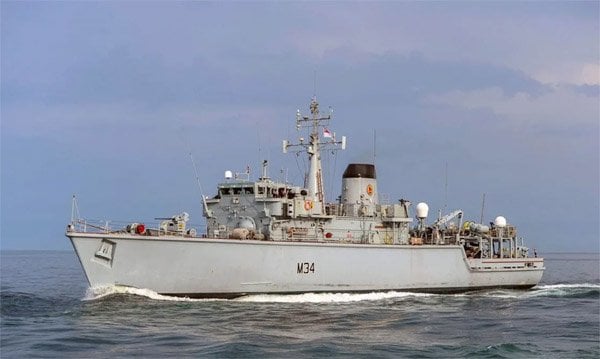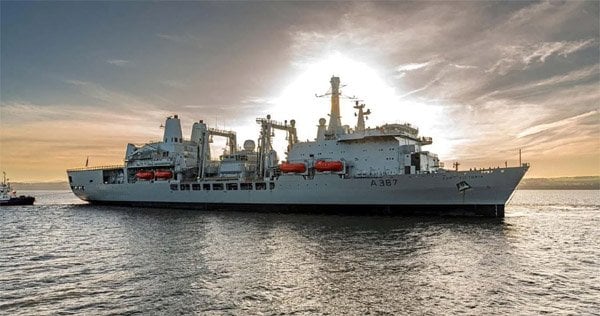Royal Navy's Bahrain-Based Frigate Slinks Back Home Silently
Without any announcement, and with a dearth of official information concerning its whereabouts, the Royal Navy appears to have withdrawn its permanently deployed frigate in the Gulf, HMS Lancaster (F229).
The last public appearance of HMS Lancaster (F229), a Type 23 frigate, was when carrying out yet another successful drug smuggling interdiction in the Gulf of Oman on October 12. A Royal Marine sniper on board HMS Lancaster's Wildcat helicopter disabled the motor of a skiff travelling at 40 knots, and the ship's crew was then able to recover heroin, crystal meth, and hashish worth $45 million. Since then, HMS Lancaster has not been sighted, and the only vessel alongside at the HMS Juffair base in Bahrain has been the Hunt-class minesweeper HMS Middleton (M34), which, with its trusty 30mm cannon, is now the Royal Navy's Middle East flagship.
HMS Lancaster is likely to be returning to the United Kingdom, in company for logistic support with RFA Tidespring (A136). Tidespring was last spotted in Cape Town on November 12, and although HMS Lancaster was not seen alongside, both vessels are likely to be back in the UK at the beginning of December, possibly joining up with the HMS Prince of Wales (R09) carrier strike group as it too returns home after its deployment to the Far East.
The Royal Navy has not announced whether HMS Lancaster is to be replaced, either in the short term by one of the two offshore patrol boats, HMS Tamar (P233) and HMS Spey (P234), based in Singapore, or in the longer term by one of the Type 31 frigates yet to be launched.
In the meantime, with the internal security situation in Iran deteriorating and tensions rising, the Royal Navy's presence in the region will be maintained by HMS Middleton. Once one of three vessels in the 9th Mine Counter Measures Squadron, Middleton provides a base afloat for a valuable mine counter-measures capability should trouble arise in the Straits of Hormuz area, as tends to occur when Iran goes through a period of tension.

HMS Middleton (M34) (Royal Navy)
The Royal Navy is currently suffering significant shortages, caused by shortages of budget, manpower, and replacements for obsolescent ships, and has been reluctant to acknowledge that these are affecting operational requirements.
Of six Type 45 destroyers, only two are operational - HMS Dauntless (D33) and HMS Dragon (D35), with HMS Daring (D32) returning to service after a refit lasting over 3,000 days. Of the eight remaining Type 23 frigates, HMS Richmond (F239) and HMS Somerset (F82) are active, with HMS Lancaster (F229) on its way home to be retired shortly. The Type 23s are being replaced by Type 31s, with HMS Venturer due in service by 2027, and by Type 26s, with HMS Glasgow due in service in 2028.
The Royal Navy now appears to be without its amphibious warfare capability entirely. All three Royal Fleet Auxiliary Bay Class amphibious warfare vessels are inactive, for manpower or budgetary reasons: RFA Lyme Bay (L3007), RFA Mounts Bay (L3008), and RFA Cardigan Bay (L3009). Albion Class assault ships HMS Albion (L14) and HMS Bulwark (L15) are being decommissioned, and the hospital ship RFA Argus (A135) has been condemned as being insufficiently seaworthy to prevent even a move from its berth in the Portsmouth Naval Base. Without RFA Fort Victoria (A387), the fleet does not have a single vessel able to supply ammunition and food at sea. On its Far East cruise, HMS Prince of Wales (R09) was dependent for such support on the Norwegian logistics vessel HNoMS Maud (A530).

RFA Fort Victoria has been laid up in Liverpool (Royal Navy)
The submarine service is also under pressure. Cruises by the Dreadnought Class nuclear ballistic missile submarines, one of which is always on patrol, are having to be extended to record durations because of the lack of serviceable boats to maintain the rotation. Of the seven Astute Class nuclear attack submarines, two are still to enter service, and none of the five active boats are currently believed to be operational. The HMS Prince of Wales carrier strike group is believed to have been deployed without a submarine escort, contrary to standard practice.
Faced by these issues, the response of the UK's Ministry of Defence has been to highlight what the future procurement program will deliver, without acknowledging that short-term problems exist. There has, however, been no significant uplift to the defense budget in the interim, which is at the heart of the operational issues facing the Royal Navy.
Content Original Link:
" target="_blank">




















































